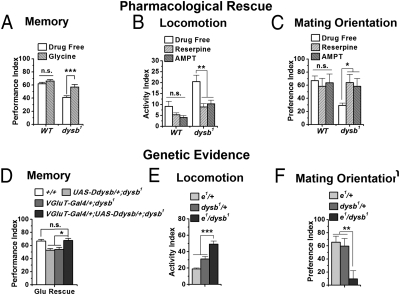Fig. 5.
Hypoglutamate and hyperdopamine levels are responsible for different behavioral phenotypes. (A) Feeding flies with glycine, an NMDA receptor agonist, restored the 3-min associative memory in the dysb1 mutant (t test; P = 0.0007; n = 9–12) without significantly affecting WT flies (t test; P = 0.17; n = 12). (B and C) Feeding flies with reserpine, a vesicular monoamine transporter inhibitor, and AMPT, a TH inhibitor, suppressed the increased locomotion and disorientated mating behavior in the dysb1 mutant (ANOVA; n = 9–12 for locomotor test; n = 20–57 for mating test) but did not significantly influence WT flies. (D) Expression of Ddysb specifically in the glutamatergic neurons (VGluT-Gal4/+;UAS-Ddysb/+;dysb1) is sufficient to rescue the 3-min associative memory deficit in the dysb1 mutant (ANOVA; n = 14). (E and F) Genetic complementation test between dysb1 and ebony1 (e1) Compared with parental controls (e1/+ and dysb1/+), the double heterozygotes (e1/dysb1) showed significant locomotor hyperactivity (ANOVA; n = 15–16) and mating disorientation (ANOVA; n = 34–36). Data are means ± SEM. *P < 0.05; **P < 0.01; ***P < 0.001; n.s., not significant (P > 0.05).

